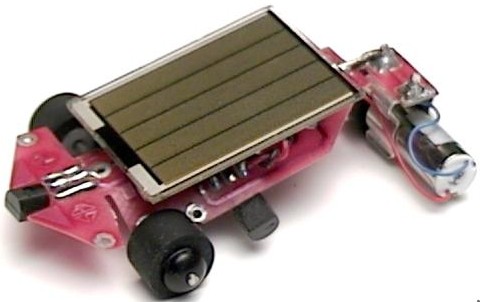General Description
This project refers to a small solar-powered car, as designed by Solarbotics Ltd. of Calgary, Alberta, Canada. The kit is available under the name SolarSpeeder 1.1. When assembled, it looks very compact (2.5 by 1.5 inches), as shown in the next photograph. This is a more-efficient second generation of the roller. I also built the first generation in 1997.

Construction
The car's construction is based on a 3D printed circuit board (PCB), with a single sided metal on a very thin laminate (indigo colour). It is powered by a solar cell (located on top of the PCB). The cell charges a very large capacitor (0.33 F) located under the PCB. When the voltage on the capacitor reaches around 2.2 V, a low-power voltage trigger (1381 by Panasonic) turns ON two transistors (NPN, 2N3904 and PNP, 2N3906). This closes the circuit for a tiny very-high-efficiency motor (located in the right side of the photograph), and the model moves.
Workshop 1: Undergraduates
A workshop on the assembly of the car was provided to 26 undergraduate students at the Department of Electrical and Computer Engineering, University of Manitoba, Winnipeg, EITC Room E2-330, on Friday, November 18, 2005, 2:30 to 5:00 PM. I presented the principles of operation of a solar engine, as well as the concept of biomorphic autonomous robots operating on the principle of stimulus-response based on an artificial "spinal cord", rather then on a higher-level decision making through an artificial "brain" (computer).
Much time was given to learning how to solder properly, without injuries to anyone. A discussion about different types of solder and the corresponding melting temperatures was included.
The skills acquired during this workshop will be used in the next event, as described next.
Workshop 2: Peguis First Nation
A workshop on the assembly of the car was provided to 24 high-school students from the Peguis First Nation (Grades 11 and 12) at the Science and Technology Symposium, Victoria Inn, Winnipeg, on Monday, November 21, 2005, 1:00 to 2:45 PM. Together with the teaching assistants attending Workshop 1 (see above), we built 24 SolarSpeeders. The completed rollers were taken home by the students to show the accomplishments to their parents and friends, as well as to experiment at their schools under the supervision of their teachers.
Workshop 3: Peguis First Nation
Workshop 2 was repeated to 24 high-school students from the Peguis First Nation (Grades 11 and 12) at the Science and Technology Symposium, Victoria Inn, Winnipeg, on Tuesday, November 22, 2005, 10:15 to 12:00 PM.
Final Remarks
-
Disclaimer of Liability
This author and the University of Manitoba are not responsible for any special, incidental, or consequential damages resulting from any breach of warranty, or under any legal theory, inclluding lost profits, downtime, goodwill, damage to or replacement of equipment or property, and any costs or recovering of any material or goods associated with the assembly or use of the product described here.
Acknowledgements
This author would like to thank all the volunteers who helped during the workshops at the Peguis First Nation Science and Technology Seminar. Financial support for the workshops from the Peguis First Nation, and the Faculty of Engineering is acknowledged. In-kind financial support from the University of Manitoba is also acknowledged.
Feedback
- Please provide any feedback.
Assembly Manual Downloading
Download the followig Adobe PDF file.
- ss11_manual.pdf (PDF; 2.4 MB)
Reference
- [Sola05]
- Solarbotics, BEAM Robotics Solar Kit #5: The BEAM SolarSpeeder 1.1 Solaroller. Calgary, AB: Solarbotics Ltd.; June 2, 2005, 16 pp.
|
![[Title Logo]](../../cpics/logos/tlogo.jpg)
![[Title]](../../cpics/logos/title.gif)
![[Research]](../../cpics/btns/resch.gif)
![[Teaching]](../../cpics/btns/teach.gif)
![[Projects]](../../cpics/btns/projon.gif)
![[Service]](../../cpics/btns/serv.gif)
![[Personal]](../../cpics/btns/pers.gif)
![[Links]](../../cpics/btns/links.gif)
![[What's New]](../../cpics/btns/snew.gif)
![[Home]](../../cpics/btns/surf.gif)
![[Title Logo]](../../cpics/logos/tlogo.jpg)
![[Title]](../../cpics/logos/title.gif)
![[Research]](../../cpics/btns/resch.gif)
![[Teaching]](../../cpics/btns/teach.gif)
![[Projects]](../../cpics/btns/projon.gif)
![[Service]](../../cpics/btns/serv.gif)
![[Personal]](../../cpics/btns/pers.gif)
![[Links]](../../cpics/btns/links.gif)
![[What's New]](../../cpics/btns/snew.gif)
![[Home]](../../cpics/btns/surf.gif)
 Home
Home
 Projects
Projects
 Robotics
Robotics
 SolarSpeeder
SolarSpeeder
![[Small Logo]](../../cpics/logos/slogo.gif) Thanks for the visit. Your suggestions and questions are always welcome (v.1.70)
Thanks for the visit. Your suggestions and questions are always welcome (v.1.70)![[Copyright]](../../cpics/btns/copyrt.gif)